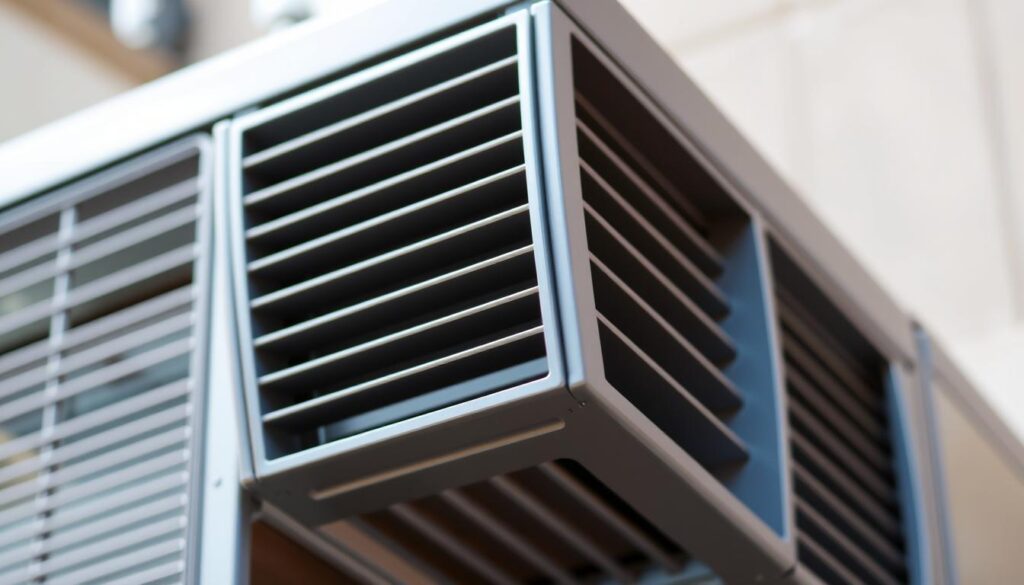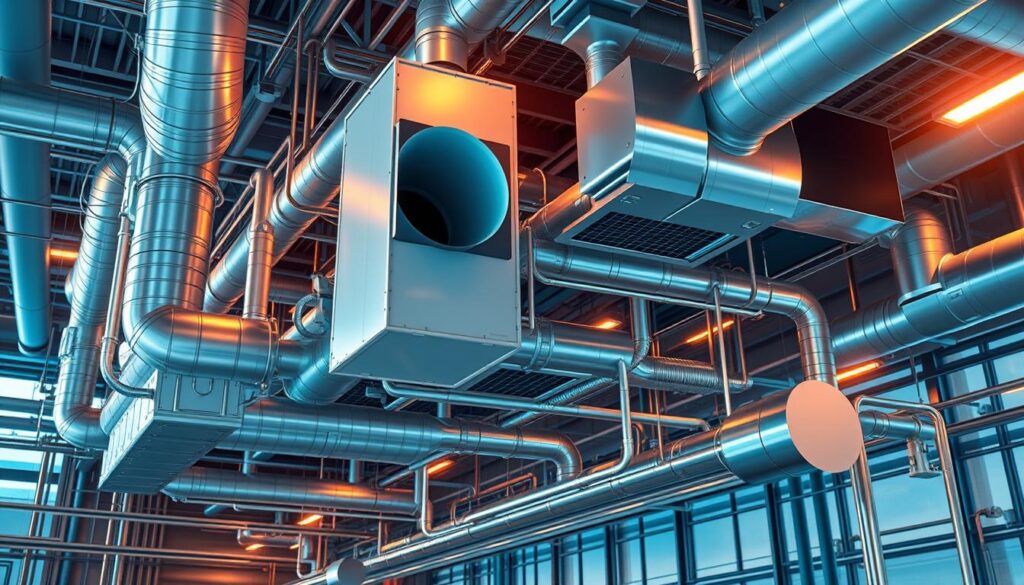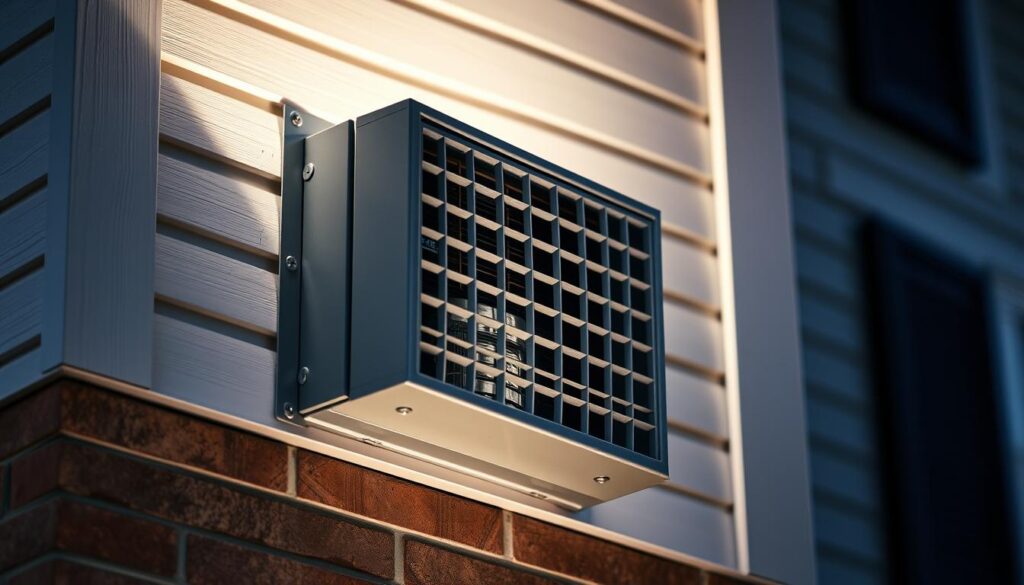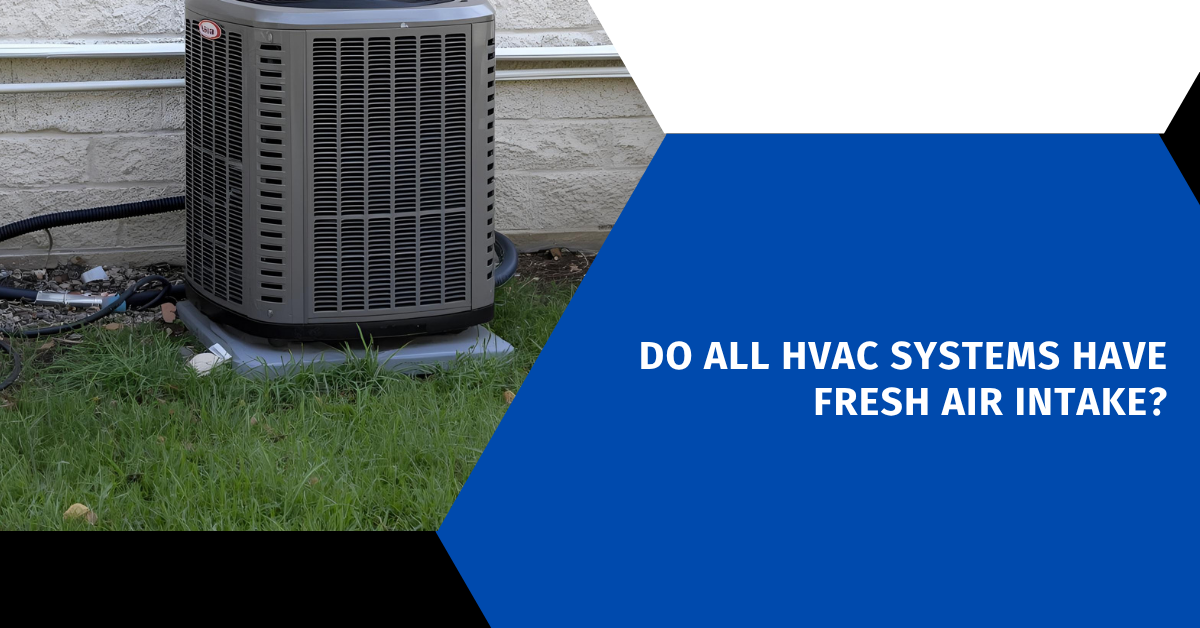Affiliate Disclosure
HVAC Guide Guys is a participant in the Amazon Services LLC Associates Program, an affiliate advertising program designed to provide a means for sites to earn advertising fees by advertising and linking to Amazon.
Do All HVAC Systems Have Fresh Air Intake? Ever thought about where the air in your home comes from? Is it from one source or many? The idea that all HVAC systems have fresh air intake is not as simple as it seems.

Not every HVAC system is the same when it comes to air flow. Some older systems just recirculate the air inside. But newer systems usually have special parts to bring in fresh air to improve the air quality inside.
Knowing how your HVAC system brings in fresh air can really change your home’s comfort, health, and how much energy it uses. Different HVAC systems handle bringing in outdoor air in different ways. It’s important to understand what your system does.
Key Takeaways
- Not all HVAC systems include fresh air intake mechanisms
- Modern HVAC systems typically prioritize outdoor air ventilation
- Fresh air intake improves overall indoor air quality
- Older HVAC systems might lack dedicated fresh air intake vents
- Regular system evaluation helps ensure proper ventilation
Table of Contents
Understanding HVAC Fresh Air Intake Basics
Fresh air intake is key in modern heating, ventilation, and air conditioning systems. Your HVAC system doesn’t just recirculate air inside. It also brings in outdoor air to keep your indoor air healthy. This outdoor air supply is vital for air quality and comfort.
Knowing how fresh air systems work helps you see their importance. They keep your indoor spaces clean and comfy. Let’s dive into the basics of HVAC air intake.
Essential Components of Fresh Air Intake Systems
- Air intake vents
- Filtration systems
- Ductwork connections
- Dampers and control mechanisms
- Air quality sensors
How Fresh Air Intake Works
The fresh air intake process involves several key steps:
- Outdoor air is drawn through dedicated intake vents
- Air passes through high-efficiency filters
- Filtered air is conditioned to match indoor temperature
- Clean, temperature-controlled air is distributed throughout the space
Ventilation Method Comparison
| Ventilation Type | Key Characteristics | Best Used For |
|---|---|---|
| Natural Ventilation | Passive air movement | Mild climates, low-density spaces |
| Mechanical Ventilation | Controlled air exchange | Complex buildings, precise air quality control |
| Balanced Ventilation | Equal intake and exhaust | Energy-efficient buildings |
Your HVAC system’s fresh air intake is more than a technical feature. It’s essential for clean, healthy air. Understanding these systems helps you make better choices for your indoor air quality.
Do All HVAC Systems Have Fresh Air Intake?
Not all HVAC systems have fresh air intake as a standard feature. Your home’s heating and cooling system might only recirculate indoor air. It’s important to know if your HVAC system has a fresh air intake for good indoor air quality.
Different HVAC systems have different fresh air intake capabilities. Several factors decide if a system includes this feature:
- System age and design
- Local mechanical ventilation code requirements
- Building type and usage
- Energy efficiency standards
Modern HVAC systems often include fresh air intake. Older or basic systems might not have this feature, affecting your indoor air. Buildings, whether residential or commercial, have different ventilation needs.
| HVAC System Type | Fresh Air Intake Likelihood |
|---|---|
| Central Air Conditioning | High |
| Heat Pumps | Medium |
| Ductless Mini-Splits | Low |
If you’re worried about your HVAC system’s ventilation, get a professional’s help. They can check your system and suggest ways to improve air quality and meet ventilation codes.
Explore Our HVAC Shop
Looking for top-rated HVAC tools, parts, and accessories? Visit our shop and find the perfect solution for your needs.
Visit the ShopBenefits of Fresh Air Intake in HVAC Systems
Modern HVAC systems do more than just control temperature. They bring in fresh air, improving air quality, energy use, and health.
Your building’s air exchange is key to a healthy indoor space. Good ventilation is essential for comfort and safety.
Indoor Air Quality Improvement
Fresh air intake cuts down indoor pollutants by bringing in clean air. This helps:
- Dilute airborne contaminants
- Remove stale air and odors
- Decrease concentration of allergens
- Prevent moisture buildup
Energy Efficiency Advantages
Building ventilation standards can save a lot of energy. Fresh air intake reduces system strain and boosts performance.
| Ventilation Strategy | Energy Savings |
|---|---|
| Balanced Ventilation | 15-25% reduction |
| Heat Recovery Ventilation | 30-40% efficiency improvement |
Health and Comfort Benefits
Your indoor space affects your health. Fresh air intake helps:
- Reduced respiratory risks
- Enhanced cognitive performance
- Better sleep quality
- Decreased transmission of airborne diseases
Investing in proper air exchange isn’t just about comfort—it’s about creating healthier living and working spaces.
Modern vs Traditional HVAC Systems

The world of HVAC has changed a lot in recent years. Old HVAC systems didn’t always get fresh air right. They mostly relied on air moving in and out on its own. But now, we have new systems that change how we manage air inside.
Today’s HVAC tech has made a big difference in how we ventilate:
- Energy Recovery Ventilators (ERVs) capture and transfer energy while introducing fresh air
- Heat Recovery Ventilators (HRVs) minimize heat loss during air exchange
- Smart sensors monitor and adjust air quality in real-time
Knowing about these new technologies is key to a comfortable home. Old systems let air in and out as it pleased, which wasn’t always good. New systems let you control the air you breathe.
Here’s what sets modern HVAC apart from the old:
- Precision air intake control
- Enhanced energy efficiency
- Advanced filtration capabilities
- Integration with smart home technologies
Choosing modern HVAC can make your air cleaner and save energy. These new systems are a big step towards better homes.
Explore Our HVAC Shop
Looking for top-rated HVAC tools, parts, and accessories? Visit our shop and find the perfect solution for your needs.
Visit the ShopCommercial HVAC Fresh Air Requirements
Commercial buildings need advanced ventilation systems for good air quality and health. It’s key for managers and designers to know the HVAC makeup air needs.
Building ventilation standards are vital for commercial spaces. They make sure your HVAC system has enough air flow and follows safety rules.
Key Building Code Standards
Commercial HVAC systems must follow certain ventilation rules. These rules change based on:
- Occupancy type and building purpose
- Square footage of the space
- Number of occupants
- Specific usage requirements
Ventilation Rate Guidelines
The American Society of Heating, Refrigerating and Air-Conditioning Engineers (ASHRAE) sets guidelines for ventilation rates. These standards help figure out how much fresh air different commercial spaces need.
| Building Type | Minimum Ventilation Rate | Key Considerations |
|---|---|---|
| Office Spaces | 5 CFM per person | Based on occupancy density |
| Restaurants | 10 CFM per person | Higher ventilation due to cooking activities |
| Retail Spaces | 7.5 CFM per person | Moderate foot traffic requirements |
Commercial Building Specifications
Different commercial places have special air needs. Places like labs, kitchens, and healthcare need special air solutions that are more than usual.
Your commercial HVAC system must be efficient and keep air quality high. This ensures a healthy and comfy space for everyone.
Residential Fresh Air Intake Standards

Knowing about residential hvac outdoor air is key for a healthy home. Modern homes need advanced systems for air quality and energy use.
Residential HVAC systems have grown to meet complex air needs. New standards aim for balanced ventilation. This brings in fresh air while saving energy.
- Minimum fresh air intake rates depend on home size and occupancy
- Mechanical ventilation systems must meet local building codes
- Energy-efficient homes require specialized air exchange solutions
Your home’s ventilation needs depend on several factors:
- Square footage of living space
- Number of occupants
- Local climate conditions
- Home construction type
Homeowners should get professional checks to meet current standards. Certified HVAC experts can guide you through complex rules. They help improve your home’s air quality.
“Proper ventilation is not a luxury, it’s a necessity for healthy living spaces.” – HVAC Ventilation Expert
Signs Your HVAC System Lacks Proper Ventilation
Your home’s air quality depends on good hvac ventilation. Knowing the signs of poor air exchange is important. It helps keep you healthy and comfortable at home.
Common Ventilation Issues
Poor ventilation shows in several ways. Look out for these signs:
- Persistent musty or stale odors
- Unexplained respiratory discomfort
- Visible dust accumulation
- Inconsistent room temperatures
Indoor Air Quality Problems
Bad ventilation lets pollutants build up fast. These include:
| Pollutant Type | Potential Health Impact |
|---|---|
| Volatile Organic Compounds | Respiratory irritation |
| Mold Spores | Allergic reactions |
| Excess Humidity | Increased bacterial growth |
System Performance Indicators
Your HVAC system might show ventilation problems through:
- Increased energy consumption
- Frequent system cycling
- Uneven heating or cooling
- Higher than normal utility bills
“Proper ventilation is not a luxury, but a necessity for maintaining a healthy indoor environment.” – HVAC Professional
Spotting these signs early can save your HVAC system and your health. Regular checks and maintenance are essential for good air exchange.
Explore Our HVAC Shop
Looking for top-rated HVAC tools, parts, and accessories? Visit our shop and find the perfect solution for your needs.
Visit the ShopAdding Fresh Air Intake to Existing Systems
Upgrading your HVAC system with an outdoor air supply can greatly improve your home’s air quality. Many homeowners face the challenge of lacking fresh air systems. But, it’s possible to retrofit your existing HVAC setup.
Start by talking to a professional HVAC technician when adding fresh air intake. They’ll check your current system and suggest the best way to add outdoor air.
- Assess your current HVAC system’s compatibility
- Determine the best fresh air intake method
- Consider your home’s specific layout and climate
- Budget for possible installation costs
There are several ways to add fresh air intake:
- Dedicated Fresh Air Duct: A direct way to bring outside air into your HVAC system
- Energy Recovery Ventilator (ERV): Offers ventilation while saving energy
- Standalone Ventilation Unit: Works on its own, separate from your main HVAC system
Your installation will depend on your home’s size, ductwork, and local climate. A pro will ensure it’s done right for the best results.
Improving your home’s ventilation is an investment in your health and comfort.
Adding fresh air intake does more than just improve air quality. It also helps with temperature control, reduces humidity, and can lower energy bills with the right system.
Maintenance Requirements for Fresh Air Intakes
Keeping your HVAC system well-maintained is key to good air flow. Regular care stops problems and keeps your air intake system running smoothly.
There are important steps to keep your fresh air intake system working right. These steps help keep your indoor air clean and your system running well.
Regular Inspection Tasks
- Check outdoor vents for debris and blockages
- Inspect dampers for smooth operation
- Look for signs of wear or damage
- Verify seals are intact around intake components
Cleaning and Filter Replacement
Cleaning your fresh air intake parts is key for air quality. Replacing filters often stops dust and contaminants from building up.
| Component | Cleaning Frequency | Replacement Interval |
|---|---|---|
| Air Filters | Every 3 months | 6-12 months |
| Intake Vents | Quarterly | As needed |
| Dampers | Biannually | Every 5 years |
Professional Service Guidelines
While you can do some maintenance yourself, getting a pro’s help is best. Get a professional check-up every year to catch and fix any issues early.
Professional technicians can spot problems you might miss during regular checks.
Regular maintenance is a smart move for your HVAC system. It keeps your air clean and flowing well.
Explore Our HVAC Shop
Looking for top-rated HVAC tools, parts, and accessories? Visit our shop and find the perfect solution for your needs.
Visit the ShopFresh Air Intake Installation Considerations
Installing a fresh air intake system needs careful planning and expertise. Your mechanical ventilation code requirements are key to choosing the right approach for your building.
When thinking about fresh air intake installation, consider several important factors:
- Building layout and existing HVAC infrastructure
- Local climate conditions
- Outdoor air quality
- Potential contamination sources
Getting a professional assessment is vital for proper integration with your current system. Building ventilation standards have specific guidelines for installation.
Key installation considerations include:
- Proper sizing of intake components
- Strategic placement to minimize contamination risks
- Compatibility with existing ductwork
- Integration of advanced control systems
Your installation should aim for optimal air exchange while keeping energy efficiency. Using advanced sensors like CO2 monitors can help automate fresh air intake. This ensures precise ventilation management.
It’s important to balance fresh air intake with exhaust systems. This balance is key for maintaining proper building pressurization and indoor air quality.
Conclusion
Knowing if all HVAC systems have fresh air intake is key for a healthy home or office. Not all systems come with fresh air ventilation, but it’s very beneficial. Adding it can greatly improve air quality and comfort.
Choosing to add or upgrade fresh air intake depends on several things. Modern HVAC systems often include outside air to avoid stale air. Whether your system is old or new, looking into fresh air intake can boost your air quality and system performance.
Professional HVAC technicians can check your system and suggest the best fresh air intake options. Investing in good ventilation is good for your health, comfort, and saves energy. By learning about fresh air intake, you can make smart choices for your indoor air.
Regular maintenance and expert advice are essential for the best HVAC system ventilation. Every building is different, so a custom assessment is vital for the best air quality.

